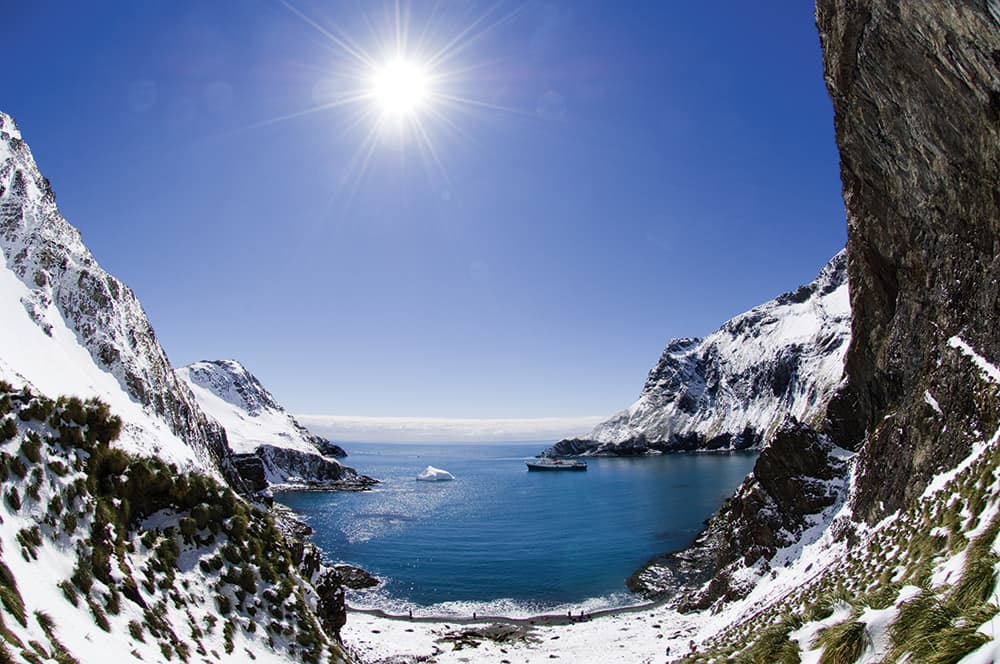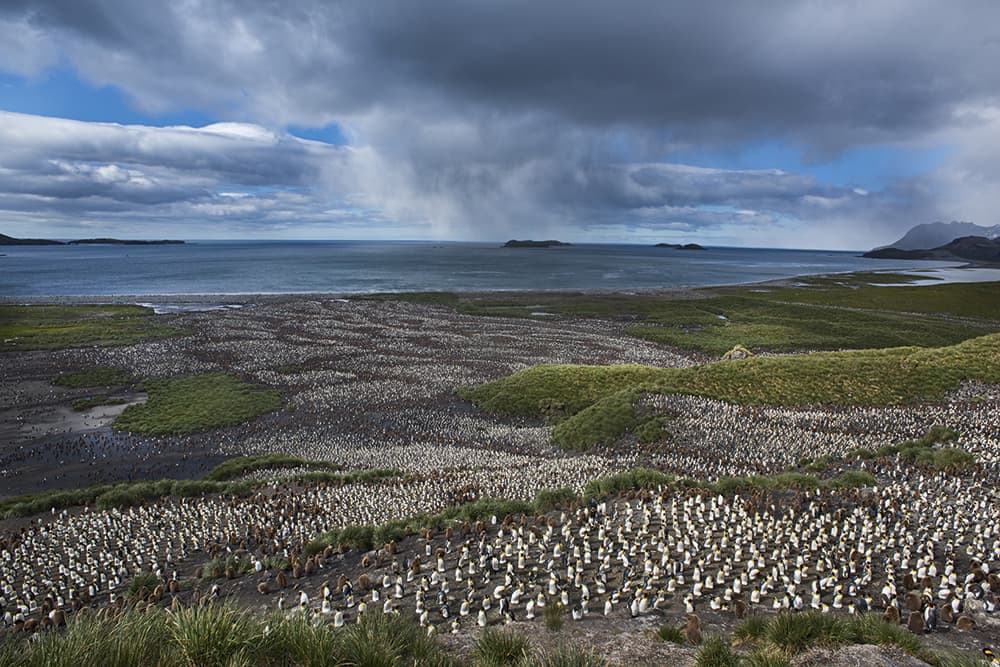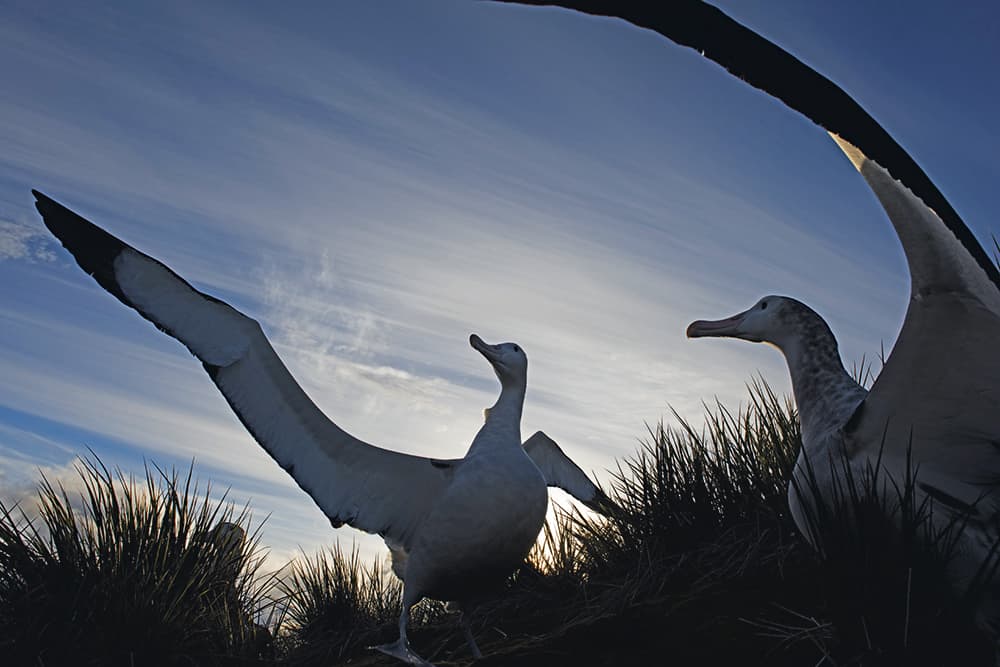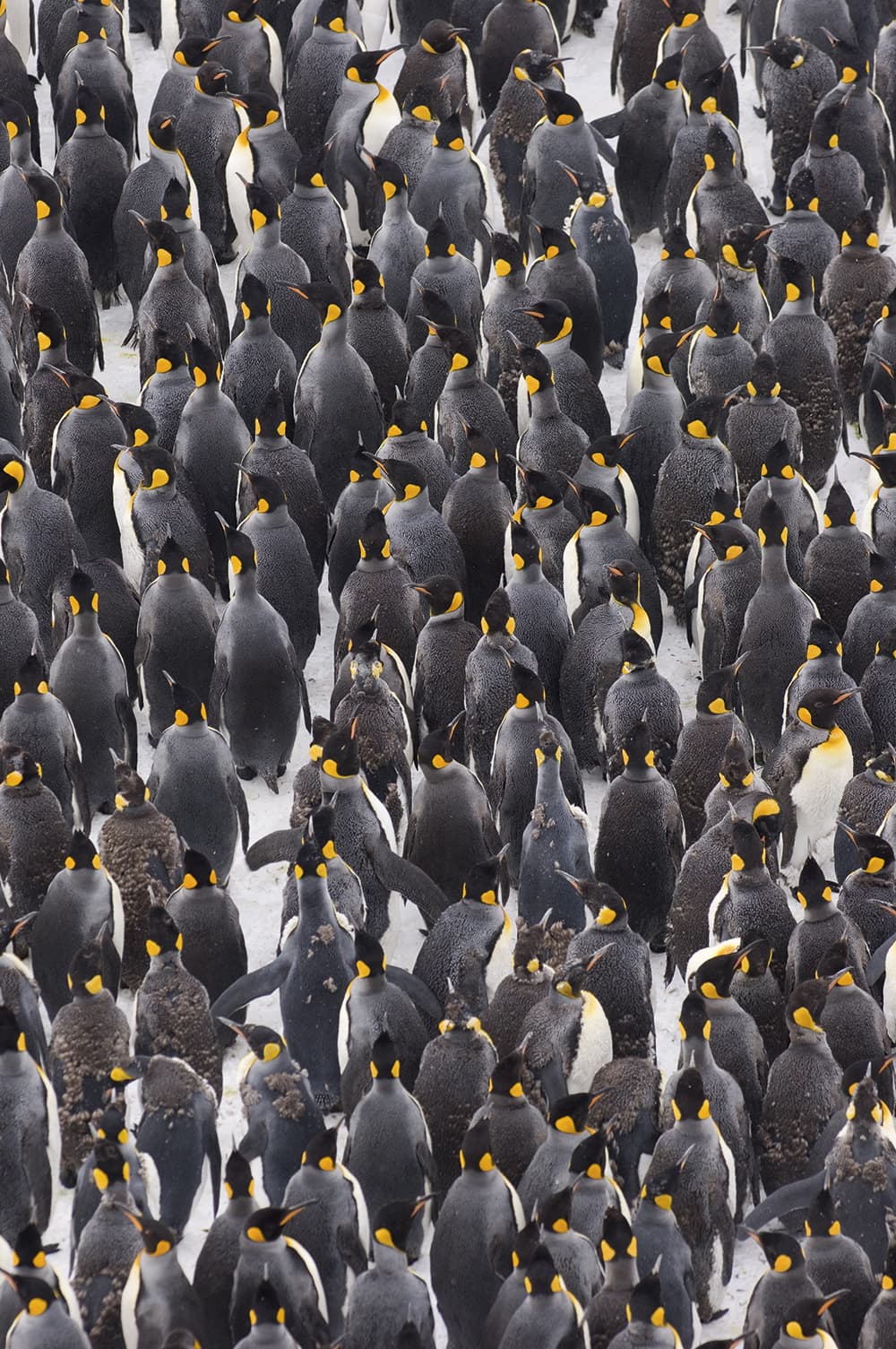In the early 1990s, a publisher lost 350 of my best pictures. That loss of so many transparencies was a heavy blow. However, it would transform my career. The resulting financial compensation gave me the opportunity to join an expedition to Antarctica, camping on sea ice next to an emperor penguin colony. So started a love affair with the far south. The resulting pictures generated revenue to allow me to travel far wider than I had previously, and ultimately return south – this time to South Georgia.
A mere speck in the vast Southern Ocean, South Georgia is just 170km long and no more than 40km wide. Glaciers, ice caps and snowfields cover 75% of its land area. This dramatic landscape towers over bays and beaches, which seethe with life during the austral summer. Feisty Antarctic fur seals crowd most beaches, an estimated three million or more making these the densest populations of marine mammals on earth. All are crowded among a scenic splendour that makes for a photographic feast, and it’s the reason why I’ve been so easily seduced into returning at every opportunity.
Extreme conditions
This concentration of life is due to the rich polar seas that surround the island. South Georgia’s position 1,390km to the west of the Falkland Islands is within the latitude known as the ‘Furious Fifties’, and places it in the grip of a turbulent storm track around Antarctica. Wild weather is an added attraction for me, as extreme conditions often translate into extreme images.
My standard telephoto lens for shooting birds in the Southern Ocean has long been the Nikon 300mm f/2.8. Easily handheld, it’s ideal for shooting birds at sea and for isolating groups or individuals within vast penguin colonies, plus it works seamlessly with a 1.4x teleconverter. The next most useful lens is the Nikon AF-S 24-70mm f/2.8G ED zoom. My philosophy when working in Antarctica and South Georgia is always to travel as light as possible.
Just prior to leaving for a trip this year, I purchased the Nikon AF-S 80-400mm f/4.5-5.6G ED VR lens. Coupled with a Nikon D810, this combination proved so versatile that it became my standard outfit. When shooting flying birds from the ship I reverted to my 300mm f/2.8, and the snappier autofocus when compared to the 80-400 zoom was a big advantage.
It soon became apparent that the Nikon 80-400mm doesn’t possess the same build quality I have come to expect from Nikon lenses. The lens barrel when zoomed out to 400mm developed a wobble that, while not affecting picture quality, was a little unnerving. The focusing stiffened up considerably, no doubt in part to the battering it was getting from spray and almost daily inclement weather. When wide open at 400mm the images were simply too soft to be acceptable. I soon realised I needed to stop down to f/6.3, and ideally f/8 to ensure crisp pictures. With those grumbles aside, the focal range was perfect. When working in penguin colonies and with seals you’re presented with constant action. Being able to zoom in and out rapidly, and respond to often-fleeting opportunities, meant I nailed many more images than I would have done if shooting with my prime lens.
Penguin colonies are rather like deciduous woodlands – a chaotic jumble in which the photographer is challenged to find a sense of order. Finding a focal point in an image illustrating a vast penguin rookery can require a slow methodical approach. I often try to find aspects within the landscape to aid this.
For example, at St Andrews Bay the penguin rookery is split in two by a fast-flowing glacial river that snakes up from the beach. There are locations on South Georgia, the best being Salisbury Plain, where you can climb to look down on sprawling colonies and it’s then that shades and shapes help create eye-catching images.
Vantage point
When the snow starts to fall and the wind starts to blow, photography in the penguin rookeries gets exciting. During an October trip in 2006 at Right Whale Bay, I got caught in almost hurricane-force katabatic winds rushing down from the mountains that arrived without warning. It was hard to stay upright. The king penguins all started to move in a long line through the blizzard to shelter in the lee of a cliff. For around an hour the wind howled and created almost white-out conditions and, at times, allowed for some really atmospheric images.
Sometimes, something unexpected unfolds that, whatever you might be shooting at the time, you can’t ignore. During an enforced three-day stay at Holmestrand, a site on South Georgia’s west coast, I was photographing some young king penguins when a young gentoo penguin chick wandered along. It was clearly lost and had a menacing pair of brown skua seabirds in pursuit. One of the skuas swooped in and got hold of its neck. At this point I faced a dilemma: the skuas needed to eat and feed their hungry nestlings, but I could have stepped in, saved this chick and returned it to the nearby gentoo colony. However, my view is that you should never interfere with nature. So over the next 40 minutes I photographed its demise, which was hard to watch at times as the chick repeatedly made it to its feet and staggered a little way before being pushed back to the ground. Eventually, it was killed and devoured.
This scene is played out around penguin rookeries on a daily basis. It’s less often photographed and, despite the hundreds of hours I’ve spent in penguin colonies, this was the first time I’ve experienced such behaviour from start to finish.
The wandering albatross
In January of this year I was invited to join a team of biologists conducting a population census of wandering albatross colonies. This would give access to places rarely visited and a chance to spend plenty of time in the field with one of the most enigmatic birds on earth. I boarded the 12-berth, 80ft-long Hans Hansson in Port Stanley in the Falklands. Our skipper, Dion Poncet, was born in Antarctic waters and has been sailing in them ever since. He knows the waters around South Georgia better than anyone. With the nimble Hans Hansson this would prove invaluable when it came to photographing from on-board ship.
The wandering albatross is the size of a swan with the longest wings of any bird, measuring almost three metres across. They are remarkably tame. Often when I lay on the ground as they displayed, their wings would brush over my hair. Getting close allows the use of wideangle lenses and enables more creativity than if restricted to using a long telephoto. My usual lens for shooting these displays was the 24-70mm zoom on a Nikon D810.
A highlight was photographing a displaying pair of wanderers at Trollheim on the south-west tip of the island. This site supports a handful of pairs but is perhaps the most dramatic of any on South Georgia, as the glaciers and snowy mountains dwarf the tussock-covered promontory on which they nest. Being able to frame the birds within this dramatic landscape as they danced in the snow epitomised why shooting wildlife on South Georgia is so rewarding.
Working in wandering albatross colonies each day was an opportunity to develop ideas. The pressures normally associated with this sort of photography, where you usually have limited time, vanished and I was able to pursue ideas for specific images. One aim was to create shots that conveyed an intimacy – a sort of bird’s-eye view. That meant getting in very close and gaining the trust of the birds. Whenever the birds started to display they’d rotate and invariably move close to me, and by lying just a few feet away I achieved camera angles that would be impossible with most avian subjects.
It took until the last evening on South Georgia for the birds to both perform and be bathed in golden light. All those days feeling frustrated in poor light weren’t wasted, as they had allowed ideas for pictures to develop. This has often been the case for me at all sorts of locations across the island. A day of rain is not a wasted day, as viewpoints can be checked and pictures planned so when the weather does get good I can focus on specific shots.
Once visited, South Georgia gets under the skin. It’s by virtue of its location an expensive place to visit, but be warned, if you go once it’ll be hard to stay away.
David Tipling is one of the most widely published wildlife photographers in the world. His pictures appear on hundreds of book and magazine covers, and have been used in many other forms, from wine labels to large projections across New York’s Times Square. www.davidtipling.com













